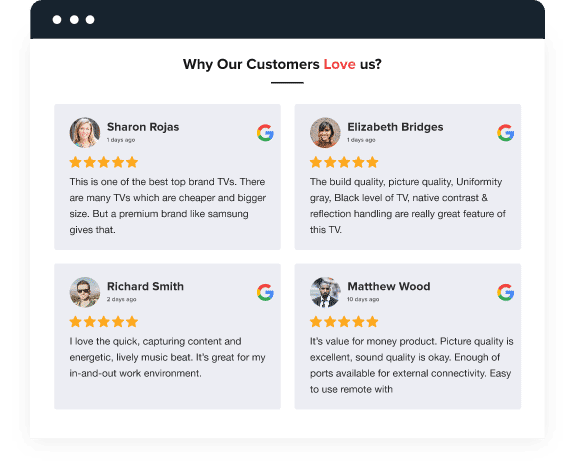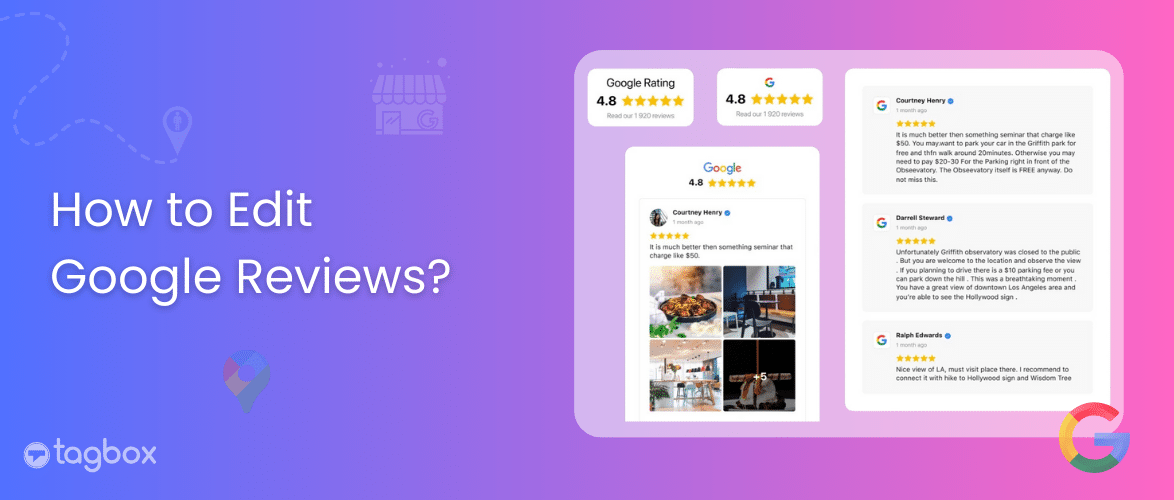Read summarized version with
Online reviews wield significant influence over a business’s reputation. Among the myriad of feedback, negative reviews stand out as the potential ones demanding careful navigation. Brands can respond to negative reviews on Google to grab an opportunity to improve their brand reputation.
Brands can use this chance to showcase their commitment to customer satisfaction and resolve issues transparently. We have created a guide to understand how to craft effective responses to negative reviews. Learning this can turn adversity into an opportunity for positive engagement.
In a landscape where consumer opinions can shape the success of a business, mastering the art of addressing negative reviews is crucial. This comprehensive guide will equip you with the skills and strategies needed to navigate the delicate terrain of online criticism. From understanding the psychology behind negative reviews to formulating empathetic and solution-driven responses, we’ll explore the nuances of managing your online reputation effectively.

Increase the visibility of your Google reviews now!
Display Google reviews on your website to increase the authenticity
Signup > It’s FREENo Credit Card Needed!
How Do Negative Reviews Affect Your Brand?
Negative reviews wield a profound impact on the digital landscape and can significantly influence consumer perceptions of your brand. Understanding the repercussions of negative reviews is crucial for devising an effective response strategy that not only mitigates damage but also fosters a positive brand image.
1) Trust Erosion
Negative reviews erode trust, a precious commodity in the business realm. When potential customers encounter unfavorable feedback, doubts about the reliability and quality of your product or service may arise.
Trust is the cornerstone of customer relationships, and negative reviews can undermine it swiftly, ultimately strengthening customer engagement and loyalty.
2) Consumer Decision-Making
Modern consumers heavily rely on online reviews to inform their purchasing decisions. A single negative review can sway potential customers away, impacting conversion rates and, consequently, revenue. The digital era has empowered consumers, giving them a platform to share experiences that hold considerable weight in the eyes of fellow shoppers.
3) Search Engine Impact
Search engines consider user-generated content, including reviews, when determining the relevance and ranking of a business. A plethora of negative reviews can adversely affect your local SEO, pushing your business down in search engine results. This, in turn, limits your visibility and reduces the likelihood of attracting new customers. In such cases, consulting negative review removal experts can help safeguard your local SEO and maintain your brand’s online visibility.
Bonus Read: Effect of Google Reviews on your Local SEO
4) Brand Image and Perception
Every negative review is an opportunity for the public to witness how a business handles criticism. Ignoring or responding poorly to negative reviews can tarnish your brand image. Conversely, thoughtful and constructive responses can showcase your commitment to customer satisfaction and transparency, mitigating potential damage.
5) Competitive Disadvantage
In a competitive market, negative reviews can provide an advantage to rival businesses. Consumers comparing options online may opt for a competitor with a more positive online reputation, leaving your business at a disadvantage.
6) Customer Retention Challenges
Existing customers may reconsider their loyalty when exposed to negative reviews. Addressing these concerns promptly and professionally is essential for retaining customer trust and preventing a ripple effect of dissatisfaction among your client base.
7) Social Media Amplification
Negative reviews often find their way onto social media platforms, amplifying their impact. Social media shares and comments can extend the reach of negative sentiments, potentially reaching a wider audience beyond the original review platform. Managing negative reviews effectively is crucial not only for the platform where the review originated but also for maintaining a positive presence across various social media channels.
8) Long-Term Reputation Consequences
Negative reviews contribute to the long-term reputation of your business. Over time, a pattern of negative reviews can establish a narrative that is difficult to overcome. Proactive management of negative feedback is crucial for shaping a positive, enduring reputation.
9) Customer Feedback Loop
Negative reviews can serve as a valuable feedback loop. Identifying recurring issues highlighted in reviews allows your business to address underlying problems systematically. By incorporating constructive feedback into your operations, you demonstrate a commitment to customer satisfaction and continuous improvement.
10) Legal and Regulatory Implications
In certain instances, negative reviews may include false or defamatory statements that could have legal implications. Understanding the legal aspects surrounding online reviews is important. While addressing negative feedback, businesses must be cautious not to violate any legal boundaries and, if necessary, seek legal advice to navigate such situations.
Why Should You Respond to a Negative Review?
Crafting thoughtful responses is a strategic move to gain benefits of Google Reviews that can positively impact your brand image. Following are some of the reasons why a brand must know how to respond to negative reviews.
1. Demonstrates Accountability
Responding to negative reviews demonstrates accountability and transparency. Acknowledging shortcomings and expressing a willingness to address issues builds trust with both the reviewer and potential customers who observe your responses. It shows that your business takes customer feedback seriously and is committed to continuous improvement.
2. Humanizes Your Brand
Personalized and empathetic responses humanize your brand. Customers appreciate businesses that engage with them on a personal level, and responding to negative reviews in a considerate manner adds a human touch to your online presence. This can foster a sense of connection and empathy, mitigating the negative impact of the initial review.
3. Corrects Misunderstandings
Negative reviews may stem from misunderstandings or miscommunications. Responding provides an opportunity to clarify any misconceptions and offer additional information that the reviewer may not be aware of. Correcting inaccuracies respectfully can contribute to a more balanced representation of your business.
4. Showcases Customer-Centric Approach
A prompt and customer-centric response signals to both the reviewer and onlookers that your business prioritizes customer satisfaction. Highlighting your commitment to addressing concerns and providing solutions showcases a proactive approach to customer service, potentially turning a dissatisfied customer into a loyal advocate.
5. Opportunity for Service Recovery
Negative reviews present a chance for service recovery. By addressing specific issues raised in the review and offering solutions or compensations when appropriate, you can potentially win back the trust of the dissatisfied customer. Turning a negative experience into a positive one can create a lasting impression.
6. Boosts SEO and Online Visibility
Engaging with reviews, including negative ones, contributes to your online presence. Search engines consider the frequency and relevance of user-generated content when determining search rankings. By responding to reviews, you actively participate in the online conversation about your brand, which can positively impact your SEO and local search rankings.
7. Encourages Positive Reviews
Responding to negative reviews can encourage other satisfied customers to share their positive experiences. When potential customers observe that your business actively engages with feedback, they may feel more inclined to leave positive reviews knowing that their opinions are valued and acknowledged.
8. Enhances Brand Image Over Time
Consistent and positive interactions with reviewers, even in challenging situations, contribute to an overall positive brand image over time. Demonstrating your dedication to customer satisfaction through responses to negative reviews can set your brand apart as one that values its customers and is committed to continuous improvement.
9. Provides Insight for Improvement
Negative reviews often contain valuable insights into areas where your business can improve. By engaging with critical feedback, you gain actionable information that can be used to enhance your products, services, or overall customer experience. This continuous improvement loop is crucial for staying competitive and meeting customer expectations.
Supercharge Your Business with Google Reviews – Get Started Now!
Signup NowHow To Respond to Negative Google Reviews?
An inadequate response to a negative review is as bad as no response at all, or maybe worse in some cases. It is as important to ensure that the review is responded to with utter professionalism and sensitivity towards the customer. The customer already has a bad experience with the company, and not responding properly can cause even more damage. Following are some points a brand must keep in mind while replying to a negative review.
a) Timeliness
Responding promptly to negative reviews is crucial. It shows that you are actively monitoring feedback and are committed to addressing concerns promptly. Delayed responses may give the impression that your business is indifferent to customer feedback.
b) Acknowledgment
Start your response by acknowledging the customer’s feedback. Express empathy and understanding, letting the reviewer know that their opinion is valued. Use language that conveys sincerity and a genuine desire to address the issues raised.
c) Personalization
Tailor your response to the specific concerns raised in the review. Avoid generic replies, as they can come across as insincere. Referencing specific details from the review demonstrates that you have thoroughly read and considered the customer’s experience.
d) Apologies
Regardless of the circumstances, offer a sincere apology for the negative experience. Taking responsibility for any shortcomings or inconveniences shows humility and a commitment to resolving issues. Avoid making excuses or shifting blame, as this can further escalate the situation.
e) Move the Conversation Offline
While it’s important to respond publicly to demonstrate transparency, invite the reviewer to continue the conversation offline. Provide contact information or a customer service email where they can discuss their concerns in more detail. This allows for a more personalized and comprehensive resolution.
f) Offer Solutions
Propose tangible solutions to address the issues raised in the review. Whether it’s a refund, a replacement, or an opportunity to revisit the service, demonstrating a willingness to make amends goes a long way. Be specific in outlining the steps you will take to rectify the situation.
e) Maintain Professionalism
Keep your responses professional and avoid engaging in arguments or heated exchanges. Responding with professionalism reflects positively on your business, even in the face of criticism. Remember that potential customers are observing how you handle challenging situations.
f) Highlight Positive Aspects
Take the opportunity to showcase the positive aspects of your business. If the negative review is an isolated incident, emphasize the majority of positive experiences your customers have had. Reinforce your commitment to providing excellent service.
g) Encourage Positive Feedback
In your response, encourage the reviewer to share their positive experiences in the future. This demonstrates a forward-focused attitude and encourages a more constructive dialogue. A customer who feels heard and sees positive change is more likely to become an advocate.
h) Learn and Improve
Use negative reviews as a learning opportunity. Analyze recurring themes or issues mentioned in multiple reviews and take proactive steps to address them. Continuous improvement based on customer feedback is key to preventing similar incidents in the future.
Bonus Read: How to Embed Google Reviews on any Website
How Big Brands Respond to Negative Google Reviews?
Here are some of the best examples of how big brands respond to negative reviews and the key takeaways from those examples.
Example 1: Home Spot
Key Takeaway: The response begins with a personalized greeting, encouraging a less formal tone by using the reviewer’s first name. It expresses gratitude to the reviewer for their time and feedback, regardless of the nature of their comments. Acknowledging any negative experience, the response offers a sincere apology rather than challenging or minimizing the customer’s perspective.
Furthermore, it invites the reviewer to share more details, emphasizing the goal of resolving the issue through open communication without delving into immediate policy explanations. The approach aims to foster dialogue, seek resolution, and preserve the customer-business relationship.
Example 2: Apple
Key Takeaways: The response showcased promptness, addressing the customer’s query within an hour. While immediate responses may not be universal, statistics indicate that 20% of customers expect a reply within 24 hours. Apple’s support used reassuring and friendly language, emphasizing understanding and commitment to assistance. Phrases like “We understand how important this is to you” create a service-oriented image.
Additionally, the response goes beyond a technical solution, encouraging the commenter to follow up, and fostering ongoing dialogue. For social media, direct messaging is suggested, while on conventional platforms like Yelp or Google, providing contact details for further communication is recommended.
Is it Possible to Remove Negative Reviews?
Deleting Google reviews is not directly within your control as a business owner. Google only removes reviews that violate their review policies, such as spam or fake content. However, you can take certain actions to address negative reviews:
Flag Inappropriate Reviews
If a negative review violates Google’s policies, you can flag it for removal. This includes reviews with inappropriate content, fake reviews, or those that don’t relate to the actual customer experience.
Increase Positive Reviews
Proactively encourage satisfied customers to leave positive reviews. Over time, an increase in positive reviews can overshadow negative ones.
Respond Professionally
Craft thoughtful and professional responses to negative reviews and positive reviews. Address the concerns raised, apologize, and demonstrate a commitment to resolving issues. This not only engages the dissatisfied customer but also shows potential customers that you value feedback.
Wrapping up!
As you engage with negative reviews on Google, remember that potential customers are closely observing how you handle adversity. Timely, empathetic, and solution-driven responses can turn dissatisfied customers into loyal advocates. Moving conversations offline, offering tangible solutions, and maintaining professionalism contribute to a positive perception of your business.
By learning from negative feedback, implementing improvements, and encouraging positive experiences, you shape a narrative that highlights your commitment to continuous growth. Embrace the opportunity to showcase the strengths of your customer service and the positive aspects of your business.
In the ever-evolving landscape of online reputation, effective responses to negative Google reviews not only address individual concerns but also contribute to building a resilient and positively perceived brand.









